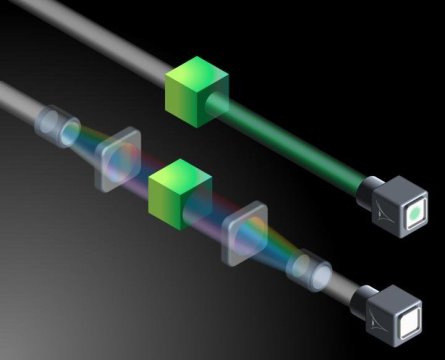
The idea of a real cloaking device that can hide objects by simply manipulating how light interacts with them has been at the forefront of researchers and engineers’ minds for quite some time. And now, thanks to a new study carried out by researchers at the National Institute of Scientific Research (INRS) in Montreal, Canada that idea could become reality sooner than they ever imagined.
This study demonstrates the use of a cloaking device based on the manipulation of the frequency of light waves as they travel through an object which is a completely new approach to the other cloaking technologies in existence at the moment. Researchers say it could be used to secure data that’s transmitted over fiber optic lines as well as be used to improve technologies used for telecommunications, sensing, and information processing.
Using this concept, the researchers say that theoretically, they could make 3D objects invisible from every direction. Most cloaking devices around at the moment can only fully hide an object when it’s illuminated with just a single color of light. The problem with that is that both sunlight and most other artificial light sources are broadband. This means that they contain several different colors within them.
The spectral invisibility cloak is designed to hide objects even under broadband illumination. The way it works is by selectively transferring energy from some colors of the wave to others. Once the wave has passed through the object the device transforms the light back to its original state.
“Our work represents a breakthrough in the quest for invisibility cloaking,” says Jose Azana of the INRS. “We have made a target object fully invisible to observation under realistic broadband illumination by propagating the illumination wave through the object with no detectable distortion, exactly as if the object and cloak were not present.”
When you look at an object, what you are really seeing is the way in which it manipulates the light waves that are interacting with the object. Most invisibility cloaking solutions involve changing the path that light travels so that waves move around an object opposed to through it. Other methods (called temporal cloaking) work by changing the propagation speed of light so that the object becomes concealed temporarily as it moves through the light beam for a certain amount of time.
“Conventional cloaking solutions rely on altering the propagation path of the illumination around the object to be concealed; this way, different colors take different amounts of time to traverse the cloak, resulting in easily detectable distortion that gives away the presence of the cloak,” explains Luis Romero Cortes of the INRS. “Our proposed solution avoids this problem by allowing the wave to propagate through the target object, rather than around it, while still avoiding any interaction between the wave and the object.”

Credit: Luis Romero Cortés and José Azaña, Institut National de la Recherche Scientifique
The way in which Azana and his team did this was by developing a technique that could rearrange different colors of broadband light so that the light wave could propagate through the object without actually making it visible to the naked eye. It works by first moving the colors closer to parts of the spectrum that won’t be affected by light propagating through it.
For example, if the object was reflecting a blue light, then light in the blue part of the spectrum may change to green so there would be no blue light for it to reflect. Once the wave passes through the object, it the cloaking device reverses the change, returning the wave back to its original state.
The cloaking device was made using two pairs of readily available electro-optical parts: a dispersive optical filter and a temporal phase modulator. While the first pair was placed in front of the optical filter, the other was placed behind it. The experiment successfully demonstrated how the device could transform light waves that would have normally been absorbed by the optical filter, then flip the process as the light made its way out the other side, making it look as though the laser had managed to propagate through a non-absorbing medium.
While there is still some work to be done before the invisibility cloak is ready for commercial or military use, it is certainly something that could someday be used in a wide range of security measures. As well as cloaking, the overall concept of reversing and redistributing energy could be used in numerous applications. The removal and reinstatement of colors in broadband waves could allow more data to be transmitted over any one link, helping to remove bottleneck and logjam issues as demand increases.
The next move for the researchers is to try and extend the concept to make an object appear invisible when illuminated from every direction. As they continue to work towards this goal they will also look to advance practical applications for one direction spectral cloaking in 1D wave systems such as applications based on fiber optics.
More News to Read
- UCLA Scientists Report Their Deepest Understanding Yet of the Enzyme Telomerase
- The World’s Most Sensitive Experiment for Dark Matter is Now Underway
- On the Hunt for Clandestine Nuclear Weapon Sites
- Without Teamwork, There will be No Colonizing on Mars
- Engineers Develop A New Cloaking Material That Can Hide Hot Objects
